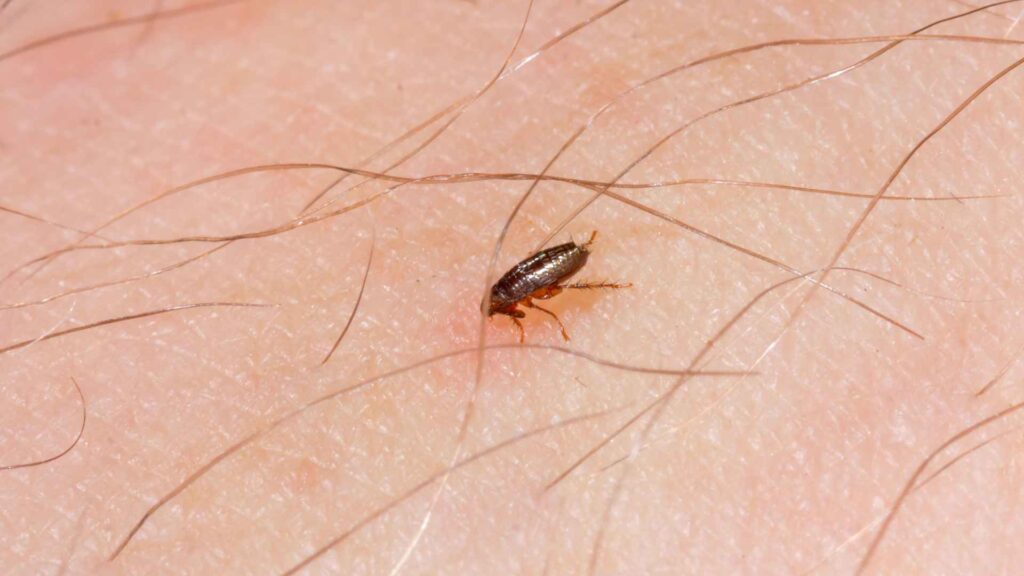Table Of Content
ToggleAs a pest control expert, I get asked this question a lot: “How do fleas get in the house without pets?”
Believe it or not, fleas are opportunistic hitchhikers, and a pet-free home isn’t necessarily flea-proof. This guide explores how fleas can invade your space, how to identify them, and effective strategies to prevent and eliminate these pesky parasites.
Fleas are wingless insects that feed on the blood of warm-blooded animals. They thrive in warm, humid environments and complete a four-stage life cycle (egg, larva, pupa, adult). Contrary to popular belief, a flea infestation doesn’t vanish overnight when a pet leaves. Flea eggs can lie dormant in carpets and furniture for months, waiting for the right conditions to hatch.
Outdoor Sources: Fleas can hitch a ride on unsuspecting wildlife like raccoons, squirrels, or stray animals wandering your yard. These animals can introduce fleas into your home through open doors, windows, or crawl spaces.
Indoor Sources: If you recently moved into a new place, consider the possibility of a previous pet infestation. Flea eggs might still be present, waiting to hatch. Additionally, shared laundry facilities or common areas in apartment buildings can be breeding grounds for fleas if other residents have pets.
Fleas can enter your home in various ways:
Tailor your pest management strategy. Start now.

Even without pets, flea bites are a telltale sign of an infestation. Flea bites appear as small, red bumps, often clustered around ankles, legs, and arms. Additionally, look for:
Focus your inspection on areas where fleas like to hide:
For additional confirmation, use flea traps specifically designed to attract and capture these pests.
Choose the best pest control frequency. Get expert guidance.

For a full-fledged infestation, consider these methods:
Need expert fumigation services? Click here to schedule an appointment.

As a pest control expert, I emphasize the importance of proactive prevention and thorough treatment when dealing with flea infestations.
By understanding how fleas enter your home and implementing the strategies outlined above, you can keep your pet-free space flea-free as well. Remember, early detection is key! If you suspect a flea problem, don’t hesitate to contact a professional for a thorough inspection and treatment plan.
Fleas can infest homes without pets due to various factors such as wildlife carrying fleas into yards or homes, previous infestations from former occupants or pets, and even through human contact where fleas attach to clothing or shoes. These opportunistic pests can find their way into homes through open doors, windows, or crawl spaces, establishing themselves in carpets, furniture, and other cozy areas.
A sudden influx of fleas in your house can occur for several reasons, including nearby wildlife bringing fleas into your yard, exposure to infested areas such as parks or wooded areas, or inadvertently bringing fleas inside on clothing or belongings after visiting places where fleas are prevalent. Additionally, flea eggs can remain dormant for months in carpets or furniture, hatching when conditions become favorable, leading to a sudden emergence of fleas.
Fleas can survive in a house without pets for several months, especially if there are favorable conditions like warmth and humidity. Flea eggs can remain dormant for extended periods until they sense the presence of a host, at which point they hatch into larvae and continue their life cycle. Regular cleaning, vacuuming, and targeted flea control measures are essential to prevent a prolonged infestation.
Even in an empty house, fleas can enter through various means such as wildlife bringing them in, previous infestations leaving behind dormant eggs that later hatch, or fleas hitchhiking on humans visiting infested areas. Fleas are adept at finding entry points like gaps in doors or windows, cracks in walls, or through ventilation systems, making it crucial to seal potential entryways and take preventive measures to keep them out.
References
https://todayshomeowner.com/pest-control/guides/what-do-fleas-look-like
Your trusted pest control experts in Southern California. Keeping your neighborhood pest-free!